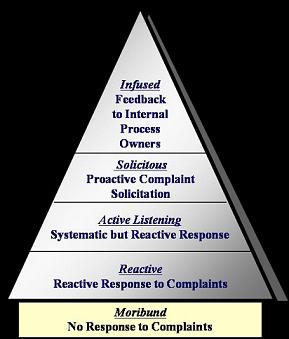The goal of service recovery strategies…
is to identify customers with issues and then to address those issues to the customers’ satisfaction to promote customer retention. However, service recovery doesn’t just happen. It is a systematic business process that must be designed properly and implemented in an organization. Perhaps more importantly, the organizational culture must be supportive of the central tenant of service recovery strategies — that customers are important and their voice has value.
~ ~ ~
Research has shown that customers who have had a service failure resolved quickly and properly are more loyal to a company than are customers who have never had a service failure — significantly more loyal. Service Recovery practices are a critical element in a Customer Loyalty Program.
Think about your own experiences with service or product problems. Did you get a quick acknowledgement of the problem, speedy resolution of the problem, and — perhaps — compensation for your troubles? (Imagine if you got a truly sincere apology and not some phony empathy?) Weren’t you more likely to buy from that company again because of the confidence you now had in their business practices? That’s the key value to effective service recovery and complaint handling: customer retention.
One way to think about service recovery is that it is a positive approach to complaint handling. Complaint handling has serious negative connotations; whereas, service recovery has positive connotations. Complaint handling is placating people, minimizing a negative. Service recovery practices are a means to achieve the potential, latent value a customer holds for a company by fostering an ongoing positive relationship.
Articles & Research on Service Recovery
- “The Profitable Art of Service Recovery,” Harvard Business Review, Hart, Heskett, & Sasser, 1990.
- Resolving Patient Complaints: A Step-By-Step Guide to Service Recovery, Osborne, 2004.
- Knock Your Socks Off Service Recovery, Zemke, 2000.
- The Handling Complaints Pocketbook, Boden, 2002.
- Complaint Management: The Heart of CRM, Stauss & Seidel, 2005.
- A Complaint is a Gift: Using Customer Feedback As a Strategic Tool, Barlow, 1996.
Articles on Service Recovery by Great Brook
Service recovery has a secondary value. It creates positive word-of-mouth about your company and minimizes the bad spin that lack of service recovery practices can create.
Next, we’ll present how to frame the argument for building Service Recovery Practices, and then we’ll examine the stages of maturity an organization may display for this vital feedback process.
Why Does Service Recovery Get No Respect?
So why isn’t service recovery part of every organizations’ business processes? No easy answer exists. Perhaps it’s the contention between operations and marketing.
Customer acquisition is sexy. Marketing conducts expensive research, fine tunes the 4Ps that comprise its marketing strategy (Product, Place, Promotion, and Price), and penetrates new customer bases through its sales and marketing programs. Companies spend big bucks on achieving sales growth and expanding market share.
Service Recovery isn’t sexy. It’s an operational task that involves negotiating with angry customers. The budget typically falls in the customer service department — one of those loathsome cost centers that drain profit. Isn’t it easier to just dismiss these upset customers and move on to greener fields?
Customer Experience Management
We evaluate clients’ current feedback processes and drive improvements for customer recovery and bonding.
Featured Services:
In some cases, it probably is easier and appropriate. Some customers cannot be recovered, only ameliorated so they don’t bad-mouth the organization. This may seem like heresy from a self-proclaimed customer service nut, but customers are not always right. (Great Brook had a person from a Pacific island nation contact us to buy our Customer Survey book. They weren’t willing to pay prior to shipment; they wanted to be invoiced. And they wanted an electronic copy of the book. We declined their business.)
However, most customers can be recovered through simple application of the Golden Rule. And those recovered and retained customers become profit centers. They buy more and they give positive recommendations to friends and colleagues, which is the most important form of “advertising”.
For a rough calculation on the potential value of a Service Recovery Program in your organization find out the annual sales volume per customer, then apply the operating profit margin to find the profit per customer. Next, find out the annual customer churn, that is, how many customers stopped buying from you — especially long-standing customers. Multiply, the churn by the profit margin and you have the potential value of the Service Recovery Program’s annual budget. You’ll probably find that even reducing a small amount of the churn will more than pay for the program. And this doesn’t even include the reduced sales from customers who didn’t leave but still have issues with the organization!
What Are the Maturity Stages of Service Recovery Strategies?
Service Recovery in an organization progresses through a series of maturity stages, shown in the nearby pyramid. Where do you stand?
 Stage 1: Moribund. There is no complaint handling. Angry customers are ignored. Drugstore.com is an example of a company with totally moribund service recovery practices. Letters to VPs and even the CEO about a damaged shipment go unanswered.
Stage 1: Moribund. There is no complaint handling. Angry customers are ignored. Drugstore.com is an example of a company with totally moribund service recovery practices. Letters to VPs and even the CEO about a damaged shipment go unanswered.
Stage 2: Reactive. Customer complaints are heard, and a response is made. But it’s a haphazard process with no defined goals for the response and no one owning this business process.
Stage 3: Active Listening. At this stage, the response to issues voiced by customers is structured. Specific people have the responsibility to respond to complaints and guidelines are in place for the response. However, it is still reactive.
Stage 4: Solicitous. The critical change from Stage 3 to 4 is the move from reactive to proactive solicitation of customers with issues. The reason this is so important is that most customers don’t bother to complain. They just move on to other suppliers of products. Haven’t we all done this? It’s a lot of work to complain!
The solicitous role is accomplished by encouraging customer to voice their complaints. Event surveys (also known as transactional or transaction-driven survey) are a commonly used technique to get issues voiced. The survey design must be such that more than just high level measurement of customer satisfaction is captured. The design must allow for action to be taken. The desire for anonymity complicates the task. (Our Survey Workshops help attendees create such actionable survey instruments.)
Stage 5: Infused. The pinnacle of Service Recovery Practices is achieved when the complaint identification merges with business process improvement or six sigma programs to support root cause identification and resolution. The owners of business processes that cause customer issues are notified of the occurrences to prompt reexamination of the process design.
In essence, we see two levels of feedback loops. First, feedback from the customer to the organization. Second, feedback from the customer-facing groups to its business partners within the organization. While company culture is clearly critical to implementing this level of feedback management, certain technologies can infuse this information sharing into business practice.
Survey Training Classes
Running your own survey programs? Learn how to do it right from us — the premier worldwide trainers for survey design & analysis.
Featured Classes:
Survey Consulting
We assist clients with their survey projects ranging from a self-help guidebook, to targeted assistance, to full service solutions.
Featured Services:



